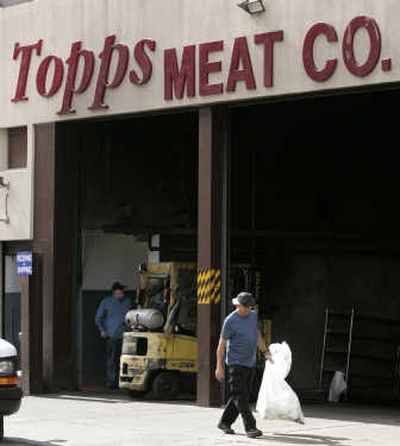USDA to speed up meat advisories

WASHINGTON – The Agriculture Department will speed up warnings about contaminated meat in the future, officials said Thursday, as they sought to quell criticism of an 18-day delay in seeking the recall of millions of pounds of tainted ground beef.
Briefing reporters, department officials acknowledged that they knew as early as Sept. 7 that frozen hamburger patties could be contaminated after preliminary tests indicated the E. coli bacteria strain O157:H7.
They said it was impossible to seek a recall without conducting a more sophisticated test to confirm the original results, but they said they would reevaluate what the USDA can do better to warn the public sooner.
“Let me be clear from the beginning: At this point we weren’t able to take action based on the initial test,” said David Goldman, assistant administrator of the USDA’s Office of Public Health Science.
Still, “this agency is not completely satisfied with the time elapsed and the issuance of the recall,” he said.
“We will be reviewing data related to this recall as well as our own protocol to determine how we might improve.”
Richard Raymond, the department’s under secretary for food safety, then added: “It’s a policy we will be changing here.”
The department’s response comes after news reports disclosed an Agriculture Department e-mail showing the department knew on Sept. 7 about possible contamination but waited 18 days before concluding Topps Meat Co. should issue a recall.
The recall that began Sept. 25 was soon expanded to comprise 21.7 million pounds of hamburger produced by Topps, based in Elizabeth, N.J. It’s the second-largest beef recall in U.S. history.
A Florida teen was hospitalized with kidney failure in August, and the meat her family bought was tested by the USDA.
The e-mail – from federal inspector Kis Robertson, an employee of the USDA’s Food Safety Inspection Service – was provided by the teen’s family lawyer, Scott P. Schlesinger, on Thursday.
“They should have recalled immediately. That’s not even a maybe,” Schlesinger said.
Asked about the delay, Topps spokeswoman Michele Williams referred questions to the USDA.
“We’ve been fully cooperating with their investigation, and certainly taking their recommendations,” she said.
In the news briefing, Agriculture officials said the Sept. 7 preliminary results yielded 13 negative samples of the questionable ground beef and just one positive result.
Subsequently, USDA scientists conducted a more sophisticated test, known as the Pulsed Field Gel Electrophoresis, which took an additional seven days due to some unexpected glitches.
Those results became available on Sept. 14, but the USDA did not act immediately because the suspected meat had been opened in the consumer’s home, raising the question of whether it had been contaminated there.
As part of USDA policy, the department does not immediately seek a recall in such situations until it gets a second confirmation elsewhere, which it received days later when New York officials reported they had run their own tests on a separate suspected E coli case and found the beef had tested positive.
The USDA’s Raymond acknowledged the department could have moved forward as soon as Sept. 14.
Raymond said the department in the future will seek a recall if officials have strong evidence of contamination, regardless of whether the tested meat had been opened in the home.
“There’s always a possibility of contamination in the home rather than the place of manufacture, but it’s unlikely,” Raymond said.
As of noon Wednesday, 29 people in eight states had E. coli infections matching the strain found in the Topps patties, the Centers for Disease Control and Prevention reported. None has died.
The first illness began July 5, and the last began on Sept. 11, the CDC said.